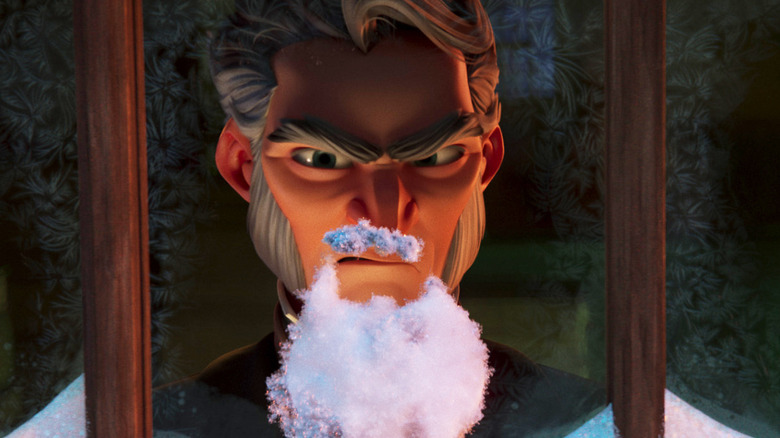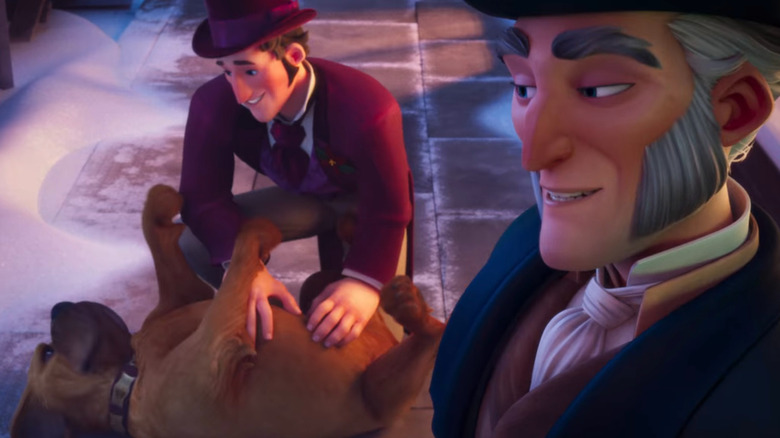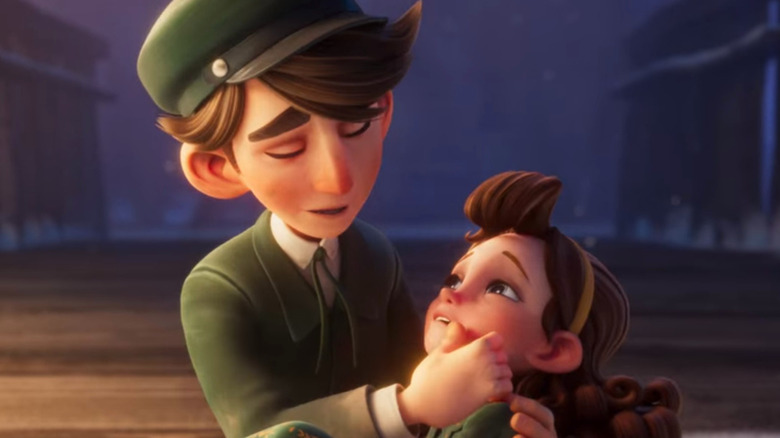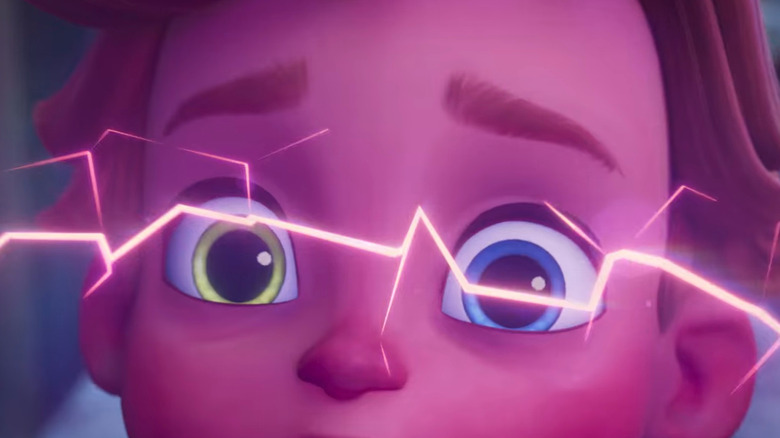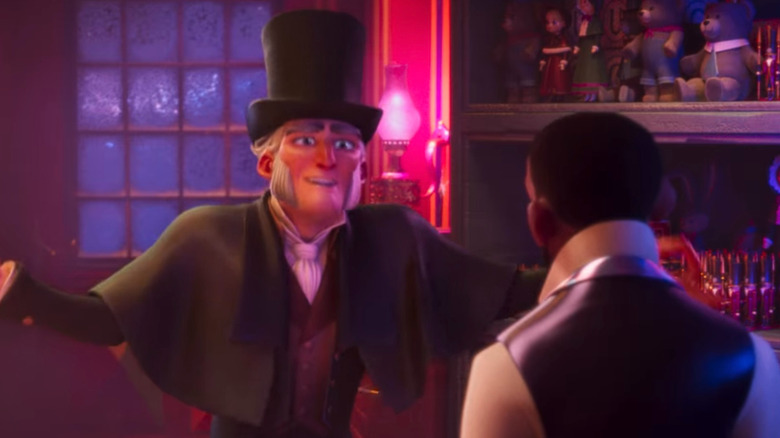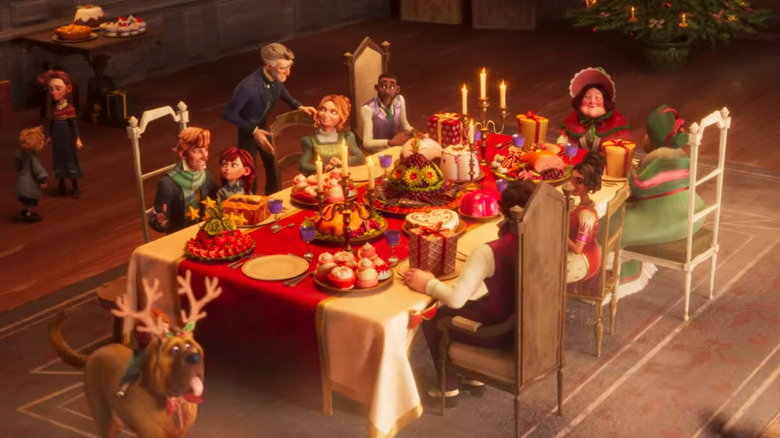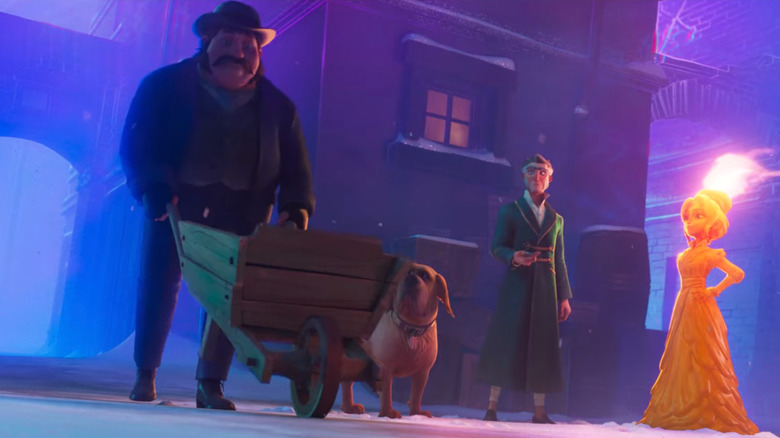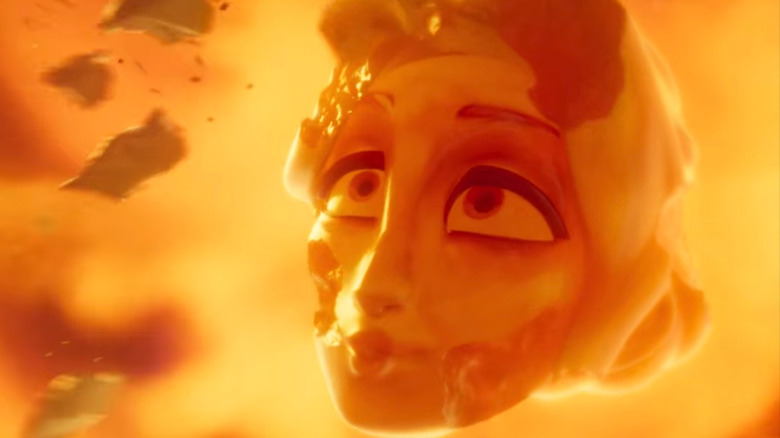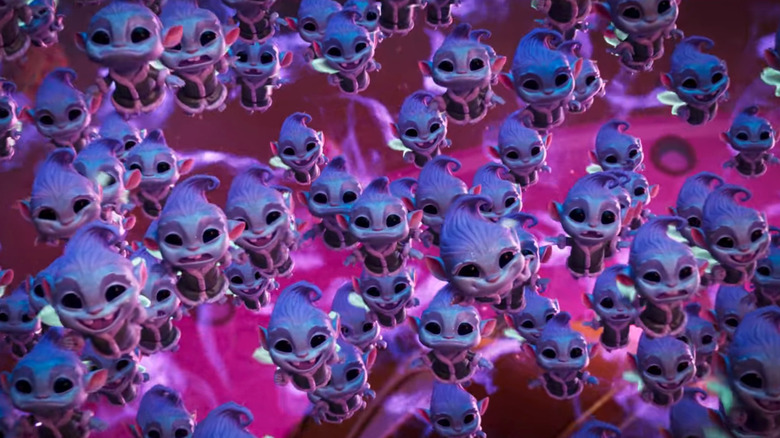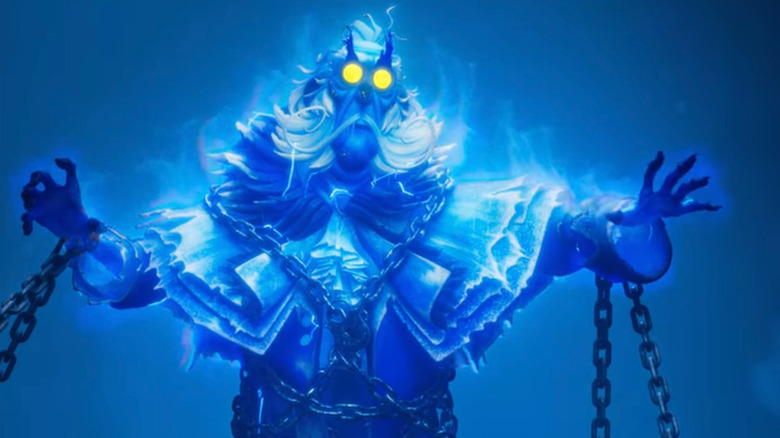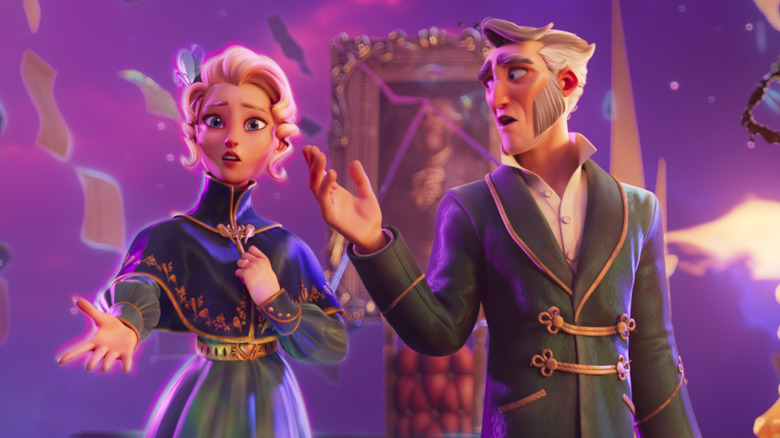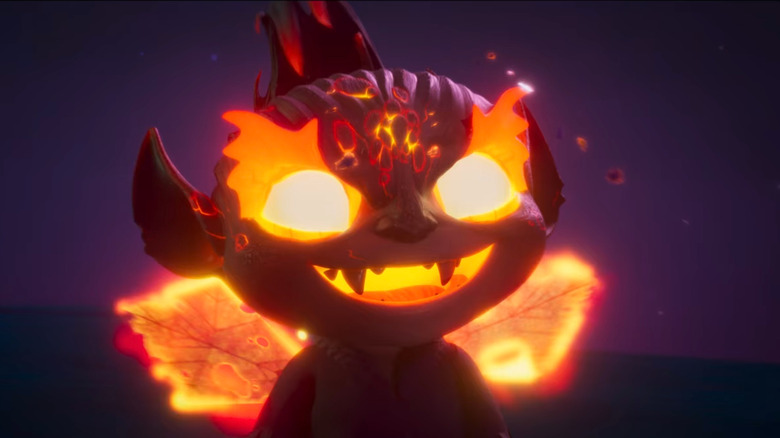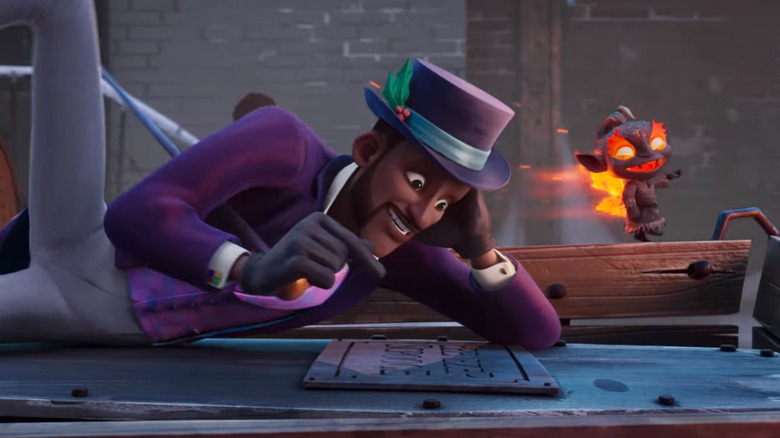12 Most Trippy Moments In Scrooge: A Christmas Carol Ranked
This post contains spoilers for "Scrooge: A Christmas Carol."
Released Friday, December 2, 2022, Netflix's "Scrooge: A Christmas Carol" is just one more entry into the literal hundreds of versions of the Charles Dickens novella that have been adapted into stage performances, films, animated specials, episodic television, and literary works since it was published in 1843. Each new rendition shares the common throughline of learning to care for one's fellow man thanks to a visitation of spirits on Christmas Eve, yet they are all different in their own ways as well.
The newest model always offers a slightly new take, a new perspective, or a new way of rendering the tale that makes it unique amongst its peers. Be it a tale told with Muppets or Mickey Mouse, manic comedians playing TV executives (internationally acknowledged as the Scrooge-iest people of all), or a Hallmark Christmas movie starring Tori Spelling, no two versions of "A Christmas Carol" are entirely the same nor entirely different. Indeed, they are a Christmas movie category unto themselves, and "Scrooge: A Christmas Carol," happily joins the ranks with its own brand of Ebenezer and a slew of trippy new details to bring this well-worn story back to life once more. Ranking these elements from least to most trippy, let's take a look at this newest Christmas classic.
12. Scrooge has a dog
It's an odd choice to give Scrooge a dog. Not that a villain can't have a dog (although according to the new "Disenchanted," a true villain's pet is a cat) because there are plenty of scoundrels across the pop culture landscape who keep vicious guard dogs at their sides. Scrooge's dog Prudence, however, is obviously a cuddle bear. In the opening moments when she comes face to face with Tiny Tim (Rupert Turnbull) and the boy nervously chuckles "Good dog" at her, Prudence's response is to lick his face. And when Scrooge's nephew Harry (Fra Fee) comes along, Prudence is quickly on her back with her paws up, ready to receive his barrage of belly rubs.
It's clear old Ebenezer (Luke Evans) doesn't offer this kind of physical affection toward her, and Prudence quite pointedly gives attitude at his miserly ways, but it's impossible to care for any living creature — and Prudence is no doubt well-cared for, with large bones, a full frame, and a loving, friendly nature — and be as unfeeling as Scrooge is always portrayed as being.
It could be argued, perhaps, that Scrooge is simply caring for her out of loyalty to Marley, whose dog she was originally, but he was supposedly the old miser Scrooge learned cold-heartedness from. Prudence is a welcome addition, no doubt, and her name is fitting for the Marleys and Scrooges of the world, but there's definitely a crazy bit of incongruity between owning this fun-loving dog and being a merciless old codger.
11. Tiny Tim and Jen had similar ailments
"Scrooge: A Christmas Carol" is, above and beyond the foundational tale, a story of parallels. The lives of Scrooge and Cratchit in the present mirror significant events from their pasts. One of the most significant ways this happens is via the bronchial illnesses of Tiny Tim and Scrooge's sister Jen (Jemima Lucy Newman). When Scrooge visits his past, his little sister sings a song outside his workhouse as she waits for him to finish for the day. Then her breath catches and she coughs roughly, unable to steady herself again.
Later, when Scrooge visits the Cratchit household with the Ghost of Christmas Present, this same scene plays out almost exactly. Tim sings the same song and collapses into the same coughing fit. This seems overly obvious in its attempt to bring Scrooge compassion for Tim as if he couldn't learn to care for him otherwise. But maybe the parallels are in his mind, as he suspects the ghosts are, to remind him of the possibilities. As he tells Past (Olivia Colman), when his father got his finances back in order they were able to afford the correct doctors and medications for Jen's treatment, and her lung ailment was healed, providing hope that Tim could be cured as well. It's a memory of the past that influences the present in order to bring forth a happier future, all twined together in concert.
10. Marley and Scrooge came in contact with Bob Cratchit in the past
Those who know the tale are aware that Bob Cratchit (Johnny Flynn) is underpaid and overworked, and in most versions of "A Christmas Carol," this is illustrated as he leaves work on Christmas Eve, having his pay docked for some infraction or another to an amount far too small to live on, much less provide a bountiful Christmas. And in most versions of "A Christmas Carol," Cratchit accepts these meager earnings with a resigned shrug and steadying swallow. Any resistance is meek and barely pressed. In Netflix's new animated "Scrooge: A Christmas Carol," however, Bob Cratchit pushes back a bit harder than those who came before him.
Of course, Mr. Scrooge cannot be swayed so easily and has a succinctly prepared speech about his own monetary needs and tough times that prevent him from extending additional courtesy to Bob. It's as hard and cold as anyone would expect from Scrooge, but viewers learn soon enough he didn't come up with it on his own. In a visit to the past, Scrooge stands with Jacob Marley (Jonathan Pryce) in front of what turns out to be Cratchit Bakery. Baby Bob Cratchit cries in his mother's arms as his father begs on his knees for an extension on his loan. Marley gives the same speech to the father, word for word, that Scrooge will give later to the son. It's a parallel that shakes Scrooge to his core, and the chains around his heart finally begin to loosen with intent.
9. Is Ebenezer a loan shark?
Ebenezer Scrooge is such a tight-fisted, rapacious gentleman, he's become a fictional archetype all his own. Anyone in even the slightest of foul moods in the month of December is at risk of being called a Scrooge or a humbug. Like other aspects of this familiar story, though, "Scrooge: A Christmas Carol" has turned the volume all the way up past 11. For this Ebenezer Scrooge isn't just an unforgiving moneylender; he's practically a loan shark.
When he visits Jenkins' Toy Shop to collect the 25 pounds he is owed, Jenkins (Giles Terera) doesn't have it due to some medical bills, but campaigns for a small extension — especially since tomorrow's Christmas. Scrooge, fake magnanimously, readily agrees to extend the due date two days to Boxing Day, for double the fee. Instead of 25 pounds, Jenkins will now owe 50 pounds, and as Jenkins tries to argue for 30, Scrooge threatens to raise it to 60. By his menacing demeanor, you may assume his next move is broken thumbs or incapacitated kneecaps. Only the worst of the worst movie criminals ask for such an unreasonable increase over such a short time period. Ebenezer might as well come barrelling down the stairs with a machine gun introducing us to his little friend. Though actually, a "Scarface Christmas Carol" would be amazing.
8. Last minute Christmas dinner
The final act of Charles Dickens's "A Christmas Carol," in almost all adaptations, sees Scrooge, thrilled to have survived the night, calling out the window to a trusty street urchin, asking for the prize goose to be bought, and sending down a shiny silver coin to get the job done. He runs through the streets singing with carolers and giving to charities. He sends the massive goose to the Cratchits, then joins his nephew's household to take them up on their annual invitation. Yet in this newest Netflix version, Scrooge doesn't go to the revelers, he makes the revelers come to him.
Upon arising from his brush with Christmas Future, Scrooge doesn't just ask for a goose, as expected, but for a whole stack of errands. He then invites all the urchin kids to stay for the festivities. And despite the last-minute notice, he seats a full table. There are all the Cratchits, who may have felt obligated to come. Mr. Jenkins is there, too, which is strange enough considering his ailing mother and his obvious disdain for Scrooge, but perhaps he also felt the invitation was more command than request. Next to Jenkins, for no discernible reason, are two of the women (virtual strangers) collecting for charity the day before. Finally, across the table are Harry and his wife. Despite clearly having their own Christmas dinner plans, to which they literally just invited Uncle Ebenezer yesterday, they've dropped everything and abandoned their guests to attend this instead. It makes for a tidy closing scene, but follows no logical rationale. It's positively trippy.
7. Rewind
As Scrooge is whisked back to revisit his past, they go all the way back to his youth and then take small steps forward in time to the next significant event he needs to remember. That first rewind, then, is a doozy, as swirls of colors and images float along the air next to the spinning, falling, tossed-about members of their party: Ebenezer, Prudence, and Past. Past, of course, thoroughly enjoys the whole ride, and Olivia Colman's delicious cackle through the scene is proof positive of that. The effect on Scrooge and his dog, however, is quite disconcerting.
Still, as the two land in a heap outside their first Christmas-gone-by destination (Past lands as delicately and gracefully as a dancer), they struggle to get their bearings and the universal symbol for a visit to the past is revealed as Scrooge's pocket watch turns rapidly in the wrong direction, unwinding time before his eyes.
They aren't quite at their destination yet, however, so while they still reset their equilibriums post-plummet, a man with a wheelbarrow hums a strange tune and passes by them in reverse. Snowflakes float upward, too. Once the time is exactly right, the snow stops its ascent and drifts back down, as the man's trajectory is immediately righted as well. He passes them again, this time in the correct direction, his tune now recognizable as "Good King Wenceslas." Reminiscent of the Angelica Schuyler performance of "Satisfied" in "Hamilton," it's a remarkably effective visual.
6. Past is a wax candle
The past is immutable, but our visits to it are not. Our memories are ephemeral and malleable. They are seen through the diffused light of experience and perspective and are often shaped by the narratives we ascribe to them. Why not represent the Ghost of Christmas Past as a living, melting, shapeshifting, illuminating candle? No other adaptation of "A Christmas Carol" has been this inventive while also being this on the nose with such a perfect visual metaphor.
Olivia Colman's Past is a candle that changes her form in order to confer information, elicit a memory, and even mock grumbly old ogres like Scrooge, and every single moment of her performance is an absolute outstanding delight. She is curious, artless, sly, vain, bossy, and hilarious. She also is the purveyor of trite old adages that, coming from a physical representation of the past, turn into clever witticisms. "The past can hurt," she says, after slapping Scrooge in the face. "You can't escape your past," she chortles, as a doorway out of a room becomes a portal into it.
Then, when Scrooge has seen all that Past can show him, she melts away. She leaves him with the final lesson, "You can't change the past, but you can learn from it." She pleads with him to remember the past as her wax flies off. She disappears, but his memories stay with him.
5. Cheerlings
No rhyme nor reason is given for the appearance of hundreds of flying imps to accompany the Ghost of Christmas Present (Trevor Dion Nicholas), but the subtitles in "Scrooge: A Christmas Carol" refer to them as Cheerlings. One might also call them terrifying nightmare demons. Tomato, to-mah-to.
Looking like a cross between Stitch and a Cornish Pixie, these little blue sprites appear to have the potential for mischievousness equal to both species combined. The audience is told they set dares, and they tempt and tease with all manner of delectable foods. They sing and dance and perform Big Band music, always having fun but never unwilling to seek the limelight all for themselves by way of pushing their brethren out of the way. The Cheerlings embrace every emotion to the extreme, embodying the fully lived life that Christmas Present himself extols. They look like a barrel of laughs, truly, and they very well may be harmless little gremlins of cheer, as their name suggests. Err on the side of caution, though, and never trust fairies — especially when they sport such persistent, vexing giggles.
4. Jacob Marley visits Scrooge
Everyone knows it's coming, but the arrival of Jacob Marley in any adaptation of Charles Dickens's famous holiday tale must be the scariest of all the ghosts. It must be the most shocking, the most unsettling, and the event most likely to set Scrooge's nerves on edge for the night to come. (There's an argument to be made that the Ghost of Christmas Future is always the scariest, but this is a misperception, as it is the events that Future reveals, not the looming, voiceless ghost itself, evoking the fear in those scenes.) Over the years, Marley has appeared as a free-floating apparition, a devilish doorknob, the rotting corpse of a golfer, and various chain-dragging zombie spirits, but however he appears, it is with a full force of horror effects to make his impact astounding.
In "Scrooge: A Christmas Carol," his reveal is stretched along the film's opening with icy whispers in the wind. "Scrooooooge," it howls, blowing out a lamppost or momentarily darkening a pathway, hinting at Marley's mustache in the frost. This happens many times, with only the slightest recognition by Ebenezer of things outside his periphery. When he finally gets home, then, and his fireplace erupts into a mountain of ice that briefly takes the shape of Marley's face before morphing back into creeping ice along the walls, you believe Scrooge's fear. And when Marley himself finally appears, born out of ice and tiny sparks of electricity, with blue flames raging behind the coins on his eyes, the audience is just as shaken.
3. Isabel says goodbye
The idea of what might have been is always a painful area to explore, particularly when in hindsight it's so clear what's at stake if one says or does the wrong thing. Ebenezer Scrooge has painful memories in his past, but the one great regret of his life is losing his love Isabel (Jessie Buckley).
Thinking he had to work harder to deserve her, to keep and provide for her, he immersed himself in a job and a lifestyle that robbed him of his soul. He forgot his priorities and resented the implication that he should give up his goals to spend more time with Isabel when in his mind it was Isabel he was working for.
As sufferers of the same human condition, we can all relate to missteps in love, so this storyline always resonates. The visual rendition of this remembered regret in "Scrooge: A Christmas Carol" is so powerful as to be almost surreal. In the scene, objects spin and freeze around the room as time starts and stops around them. Isabel sings a song to the Ebenezer of her time, begging him to finally see the pleas she has made for him to change his ways, desperate for him not to force her to walk away. Meanwhile, old Scrooge is singing to the Isabel of his past, and to his past self as well, lamenting his lack of perspective, until finally, he screams at his former self not to put her off again because this is the day everything ends. "There is no 'later,'" he sobs.
2. The change from Present to Future
The time of Christmas Present is done, and the time for Christmas Future is at hand. Usually, this means another swirling, disorienting transition in whatever manner the adaptation has used, and a figure not unlike the Grim Reaper shows up to escort Scrooge through his Christmasses to come. "Scrooge: A Christmas Carol" does this changeover quite differently.
As the Ghost of Christmas Present is saying goodbye and promising the imminent arrival of another, his hands start to glow with symbols and patterns. He seems surprised by this, then doubles over in pain before rocketing upward to twice his previous height and transforming right before Scrooge's eyes into the Ghost of Christmas Future. It's an impressive sight, but the film doesn't stop there.
As if Present's Cheerlings weren't terrifying enough, they, too, begin a seemingly traumatic transition as Future is emerging. Appearing to catch fire at their toes, they burn upwards like flash paper into charred versions of their former selves, black with hollowed-out eyes filled with flames. Plus now they have teeth and their impishness has gone from incidental to overt. The subtitles call them Fearlings now. Fearlings. Unrelated, is there somewhere one could buy a nightmare preventative pill, perhaps?
1. What's worse than dancing on someone's grave?
If someone wanted to make you feel bad about the way you've lived your life, wanted you to rethink your values and how you treated those around you, there couldn't possibly be a better way than the one employed in "Scrooge: A Christmas Carol."
When he and Future arrive at this front door, Ebenezer is surprised to see such a large gathering of townsfolk in front of it, led by Mr. Jenkins from the toy store. They are all cheering and celebrating Mr. Scrooge, grateful for what he's done for them, and Ebenezer is clueless enough not to realize his door is chained shut and there's a coffin in the cart out front. He claps and marches and sings along as the entire city full of his borrowers celebrate his death as the one worthwhile thing he's ever done for anyone. For his part, Jenkins literally dances on Scrooge's coffin, which is enough to send a shiver down the spine of even the least of superstitious people because it is downright chilling.
"A Christmas Carol" has been adapted hundreds of times, and Scrooge has been tormented by everything from poor attendance at his funeral to the coarse treatment of his body and belongings by his servants, to the literal burying or cremating of his still living body. But there has never been anything as gut-wrenching as this. The idea of people dancing on one's grave is bad enough. Having them dance on your coffin is a horrifying fate to be avoided at all costs.
